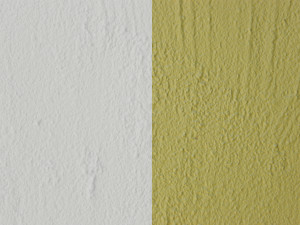What to do With Yellowing Paint
Over time, enamel solvent-based paints begin to oxidise, giving your once white walls a yellow tinge. This is a property of oil-based paints and varnishes, and cannot be avoided completely. Oxidisation can be accelerated, so we have listed a few causes and solutions to help keep your white walls white.
Causes:
- Oxidisation is the main cause of yellowed paint, and is a natural process that
occurs to the solvents in oil-based paints.
- Natural and artificial light is key to keeping oil-based paints true to colour. Inside cupboards, behind picture frames, and even behind doors that are often left open, you might notice a slight yellow tinge. Enamel paint needs light to slow down the oxidisation process. Luckily, yellowing caused by a lack of light can be reversed.
- Ammonia will also hasten the oxidisation of oil-based paints. Ammonia is a chemical that is often found in household cleaners, floor polishes, and acrylic water-based paints. Yellowing caused by ammonia cannot be reversed.
- Heat emitted from stoves, heaters, and radiators will also speed up the oxidisation process. Hot weather and humidity will cause yellowing too.
Solutions:
- The oxidisation of solvent-based paints cannot be stopped. If you want your paint to stay true to its original colour, it is best to opt for a water-based acrylic paint, especially in dark areas, or areas exposed to heat.
- Yellowing due to a lack of light can be reversed. All you have to do is expose the yellowed area to light, and the colour will change over time. The area will yellow again, however, if it is not consistently exposed to light.
- Ammonia is found in water-based paints. If you are painting an interior using both enamel and acrylic paints, make sure you use acrylic paints first. Leave the paint to dry for at least 24 hours before you use the enamel paint. Never use oil-based paints before, or at the same time, as water-based paints.
- You can paint over yellowed enamel paint with acrylic paint to fix the problem completely. Surfaces should be cleaned thoroughly, and sanded down to ensure topcoats adhere properly. Or, call in the Kraudelt team, local painters that you can rely upon and we can do the job for you.
- When varnishing, use a varnish that indicates that it is non-yellowing.
If you have areas of yellowing paint in your house and would like to get them fixed, give us a call today for a fast, accurate quote.

